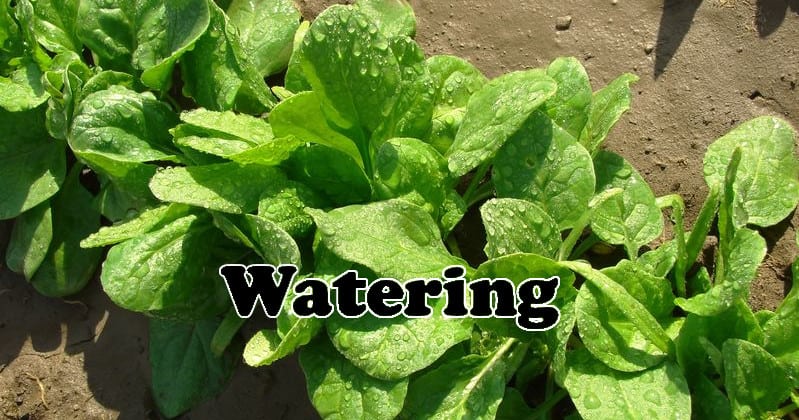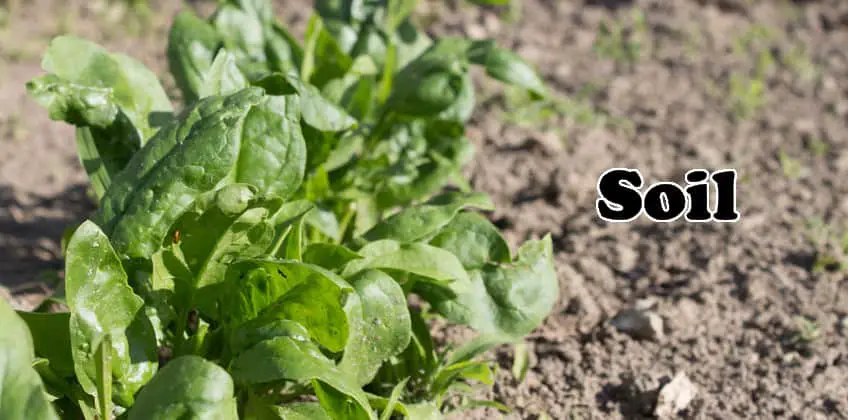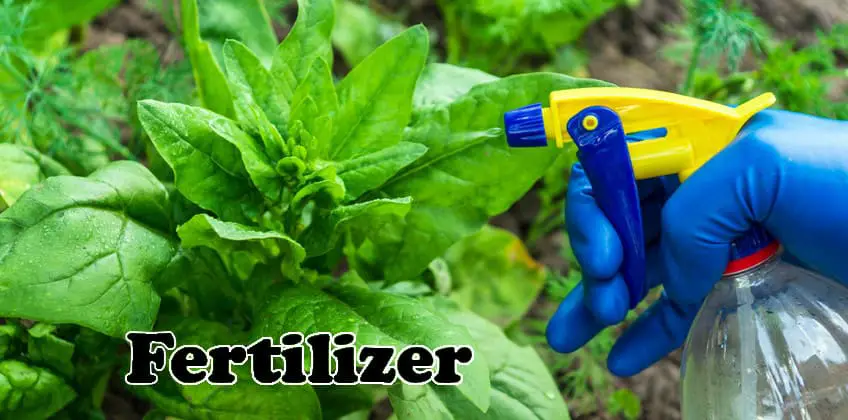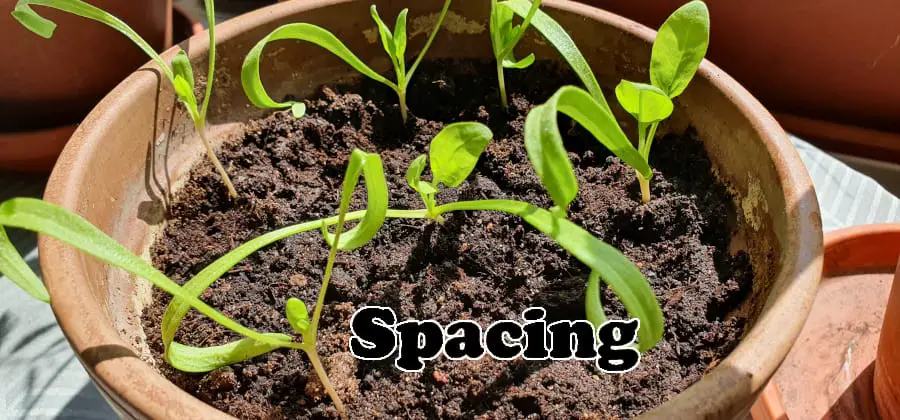This post contains affiliate links.

In order to grow the best spinach, it is important to know what growing conditions the plant needs when it comes to sunlight, temperature, watering, soil type, fertilizer, and spacing.
I have written this article to teach you precisely what you should know when it comes to the best conditions for growing spinach, whether you grow it indoors or outside and in a pot or in the ground.
First, here is a table to give you an easy overview of what you will learn in this article. Below the table, I go into a lot more detail with each point and share some good tricks you can use to make things easier.
| Sunlight | 4-14 hours per day |
| Temperature | 50-70°F (10-21°C) |
| Watering | Water frequently in small doses |
| Soil Type | Nutrient-rich and well-drained soil |
| Soil pH | Slightly acidic. pH 6.5-6.8 |
| Fertilizer | Liquid general garden fertilizer mixed into the water every 2-3 weeks |
| Spacing | In a pot: 1 plant for a 6-inches (15 cm) or more wide and deep pot. In the ground: Sow seeds 2 inches (5 cm) apart, in rows 12 to 18 inches (30-45 cm) apart. |
Best Amount of Sunlight for Spinach (And More Tips)

One of my favorite things about spinach is that it doesn’t need a lot of sunlight to grow, so you can often grow it both indoors or outside, depending on what you prefer. That said, more sunlight usually gives better results.
Spinach grows best in full sun but can also grow in partial shade. Generally speaking, spinach grows better the more sunlight it gets, so it is usually easier to grow it outside, but it can also grow really well indoors if you have a sunny spot for it. You can read more about the differences between growing spinach indoors and outside and some more tips about it on this link.
Six to 10 hours of direct sunlight per day is ideal for growing spinach, but it can grow with as little as 4 hours of sunlight per day. More sun generally means faster-growing, more productive spinach, but it should not get more than 14 hours of sunlight per day since that makes it bolt.
See if you can find a spot for your spinach where it can get those 6-10 hours of direct sunlight per day. If you are not sure where or how to do that, don’t overthink it. Just pick a sunny spot.
If you live in a very sunny area, you probably shouldn’t pick the sunniest spot you can, though, since too much sunlight (more than about 14 hours per day depending on the variety) will make your spinach bolt. When spinach begins to bolt, it will use its energy on producing seeds rather than growing and producing new leaves.
I have written another article where I explain much more about how to take care of your spinach when it comes to sunlight. You can find it here.
Best Temperature for Spinach (Plus Lowest and Highest)

The temperature has a huge impact on how well spinach grows. Too low temperatures mean slowed growth (or no growth at all), and too high temperatures mean that the spinach will begin to bolt and almost stop producing new leaves entirely. So what temperature is best for spinach?
The ideal temperature for spinach is 50-70°F (10-21°C). Spinach is relatively frost tolerant since it can tolerate temperatures as low as 20°F (about -7°C), although it grows much slower at such low temperatures. Spinach will generally begin to bolt at temperatures above 75°F (about 24°C).
The warmer it is, the faster your spinach will generally grow. For every rise of 18°F (when between 40-98°F), the growth rate doubles, according to this article from Oregon State University.
That said, once the temperature surpasses about 75°F (about 24°C), spinach will usually begin to bolt and switch from the growing stage to the seed production stage. When the plant is producing seeds, it only produces very few new leaves, and they will often be bitter and stringy.
You can read much more about when and why spinach begins to bolt and what you should do about it in one of my other articles on this link.
Since spinach can grow in a very wide temperature range, the spinach growing season is often very long and spans from early spring to late fall. Of course, that depends on where you live and how the climate is there, but spinach is usually one of the veggies with the longest growing seasons.
Best Way to Water Spinach (How, How Much, and How Often)

As with any other garden plant, proper watering is essential for growing good spinach. Luckily, watering spinach is not that hard, but doing it the best way does require some knowledge. If you know what you are doing, you can reduce the risk of damaging your spinach and significantly improve how well they grow, all while saving water. Let me teach you.
You should water spinach frequently in light doses. Once per day is usually sufficient. Try to keep the soil moist without ever letting it dry up or become completely wet. The best times to water spinach are in the early morning, late afternoon, or early evening since there isn’t much sunlight.
The reason why it is best to water at those times is that more of the water gets to seep into the soil (and thereby get used by the plant) than if you watered them during the day. The reason for this is that there is (usually) a lot more direct sunlight during the day, which will cause some of the water to evaporate and go to waste.
You can also water later in the evening, but then the water will stay in the soil around the plants’ roots for a while until the sun comes up and the plants can utilize the water. This usually isn’t a problem, but if the roots stay wet for too long, they can rot, which will kill the plant.
Remember that you should always water your spinach if it needs water. Don’t wait for the best time of the day to water it if it needs it now.
Probably the most common mistake people make when they water spinach is that they either overwater or underwater it. Either will kill the plant relatively quickly.
Once you are aware of it, underwatering is pretty easy to avoid. If the soil is dry to the touch, it is time to water it. If the spinach plant is wilting and feels loose and soft to touch, turn the watering up by a notch or two. The goal is to keep the soil consistently moist. That is how the plant thrives best.
Overwatering is harder to notice since the initial damage happens to the roots, which you can’t see. Too much water for too long will cause the roots to rot, which kills the plant. Some of the first signs you will notice are that the soil doesn’t dry up, and the plant is wilting and maybe beginning to turn yellow.
Overwatering is by far most common for people who grow spinach in pots without drainage holes. The best thing you can do to reduce the risk of overwatering is to get some pots with better drainage. I always use terra cotta pots with a drainage hole at the bottom (like these from Amazon) because the hole lets the water seep through the bottom without staying around the roots, and the material lets the water escape through the sides too.
I have another article where I write a lot more about how to tell if you are overwatering spinach, what to do about it, and how to avoid it in the future. You can find the article on this link.
The last tip I have about watering spinach is that it is best to avoid getting water on the plants themselves or splashing soil onto them by pouring the water from high above the plants. Instead, try to pour the water so it only touches the soil around the plant before it seeps into the soil.
Best Soil for Spinach (Nutrients, Drainage, PH, and More)

The soil your spinach is growing in plays a huge role in how well the plants grow, how fast they grow, and how productive they are.
The best soil for growing spinach is a nutrient-rich, well-drained soil mix that contains a high amount of organic matter, such as compost. To get the best soil, mix in some sand to improve the drainage and try to keep the soil slightly acidic with a pH value between 6.5-6.8.
In most cases, the pH value of your soil will most likely be fine, but if you really want to be sure about it so you can optimize how well your plants grow, you can get a soil test kit. You can use that to test the pH value of the soil as well as other things.
The more sand you mix into the soil, the less room there is for organic matter such as compost, but even so, it can often be a very good idea to mix some sand into the soil since it improves how well it drains. Soil with a sand content of about 30-40% is usually good for most garden plants.
Spinach doesn’t grow very well in thick, heavy soil with a lot of clay in it since the roots can’t spread as easily.
Best Fertilizer for Spinach (And How Often to Use It)

The better your soil is, the less you will have to fertilize your spinach. That said, it is almost always a good idea to fertilize spinach. So what type of fertilizer should you use, and how often should you use it?
There are a couple of ways you can fertilize spinach.
I found this article from Texas AgriLife Extension. The method recommended in the article is to apply a general garden fertilizer such as a 10-10-10 (NPK rate, read more) at the rate of 2 to 3 pounds per 100 square feet before planting the seeds.
The method I usually use is slightly different. I simply use an organic, liquid, general garden fertilizer that I mix into the water I give to my spinach about every 2-3 weeks.
How Much Space Does Spinach Need? (Potted and in the Ground)

The last thing I want to cover in this article about the best growing conditions for spinach is spacing. Giving your plants enough space is necessary for them to grow well and spinach is no exception. So how much space does spinach need?
As a general rule, spinach grows best in pots that are 6 inches (15 cm) in height and diameter or in the ground in rows that are 12-18 inches (30-45 cm) apart with 2 inches (5 cm) between each plant.
I mostly grow spinach in pots, but if you want to learn more about growing it in the ground, I recommend reading this article from PennState Extension (Pennsylvania State University), which is where I got the numbers for how much space spinach needs in the ground.
You will probably get the best plants if you plant just one per 6-inch pot (or in rows as explained above). That said, I sometimes like to sow the seeds much more densely with about one seed per square inch, like in the photo above. Each plant won’t get nearly as large if you plant them so close to each other, but you can get some very fine small, great-tasting leaves that way.
If you are interested in learning more about how spacing affects plants and what happens if they don’t get enough space, I recommend reading this article.
As I wrote earlier in this article, if you want to grow spinach in pots, I recommend using terra cotta pots with one or more drainage holes at the bottom. The material and the drainage hole reduce the risk of overwatering the plant significantly and will help you keep the soil moist and not wet or dry more easily.
If you follow the guidelines from this article, your spinach should grow really well and become very productive. If you are looking for additional ways to increase the overall yield of your spinach, I recommend heading over to this article, where I share some tips for that.

